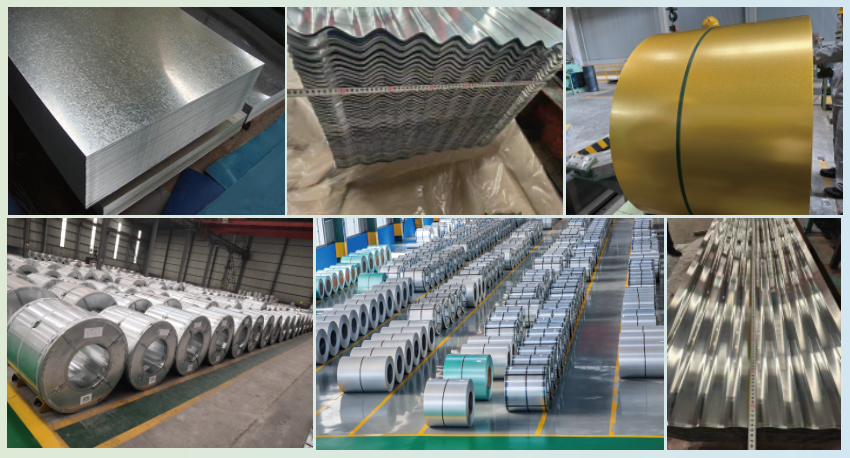/GI
The cold-rolled steel plate is immersed in molten zinc liquid (zinc layer contains a small amount of aluminum) to form a Zn-Fe alloy layer, which is mainly used in inland dry environment.
Core production step
1.Degreasing annealing
After alkaline degreasing (residual oil ≤50mg/m²), the steel plate is annealed in a reducing atmosphere (H2/N2) (650-750℃)
2.Zinc dipping
Immersed in molten zinc liquid (zinc purity ≥98.5%, containing trace aluminum 0.15-0.25%), temperature 450-465℃, forming Zn-Fe alloy layer (Gamma layer, Delta layer)
3.Air knife control
Adjust the thickness of zinc layer by air knife, and produce bright zinc flowers or no zinc flowers on the surface
/GL
The substrate is the same as GI, cold-rolled steel plate or galvanized steel plate (secondary coating), the coating composition is 55% aluminum, 43.4% zinc, 1.6% silicon, mainly used in coastal/industrial areas.
Core production step
1.Bath composition
55% aluminum + 43.4% zinc + 1.6% silicon (silicon inhibits the formation of brittle Fe-Al alloy)
2.High temperature plating
Bath temperature 590-620℃, plating time 10-20 seconds, forming Al-Zn-Si eutectic structure
3.Rapid cooling
water quenching or air cooling to prevent cracking of the coating
Product performance comparison
|
GI |
GL |
|
|
Corrosion resistance life |
10-20 years (general environment) |
20-30 years (high humidity/salt spray environment) |
|
Heat resistance |
Zinc melting point 419℃,high temperature easy oxidation |
Aluminum melting point 660℃, better heat resistance |
|
Cost |
low(zinc price<aluminum zinc alloy) |
high (but the amount per unit area can be reduced by 30%) |
|
Weldability |
excellent (good conductivityof zinc layer) |
special process required(easy oxidation of coating containing aluminum) |
|
Applications |
Roofing,Cable Trays,Greenhouses |
Coastal Structures, Factories, Exhausts |
|
Coating structure |
Pure zinc layer (Eta layer) +Zn-Fe alloy layer (total thickness 10-30μm) |
Aluminum-rich phase (corrosion resistance) + Zinc-rich phase (sacrificial protection) + silicon interface layer (enhanced bonding force) |
|
Anti-corrosion mechanism |
Sacrificial anode protection (zinc preferential oxidation), zinc layer self-healing |
The passivation film (Al2O3) of aluminum blocks the corrosive medium, and zinc provides local sacrificial protection |
Product data
|
Parameter |
GI |
GL |
|
Coating |
Zinc (≥98.5%) + Al (0.15-0.25%) |
55%Al + 43.4%Zn + 1.6%Si |
|
Coating Weight |
Z20-Z275 (20-275g/㎡ both sides) |
AZ20-AZ200 (20-200g/㎡ both sides) |
|
Salt Spray |
Z275: 500-800h (Red Rust) |
AZ150: 1500-2000h (Red Rust) |
|
Heat Resistance |
≤200℃ (Zinc Oxidation Accelerates) |
≤315℃ (Al2O3 Film Stable) |
|
Reflectivity |
30-40% |
70-80% (High Al Reflectivity) |
|
Formability |
Excellent (Zinc Ductility) |
Good (Avoid Coating Cracking) |
Material Selection Tips
|
Inland dry environment |
GI (Z180 + coating) is preferred, cost-effective |
|
Coastal/industrial zone |
GL (AZ150 + coating) is required, and the service life is increased by 2-3 times |
|
High temperature scenario |
GL heat resistance is significantly better than GI (such as chimneys, baking equipment) |
|
Coating substrate |
Select zinc-free GI or GL (better coating adhesion) |
